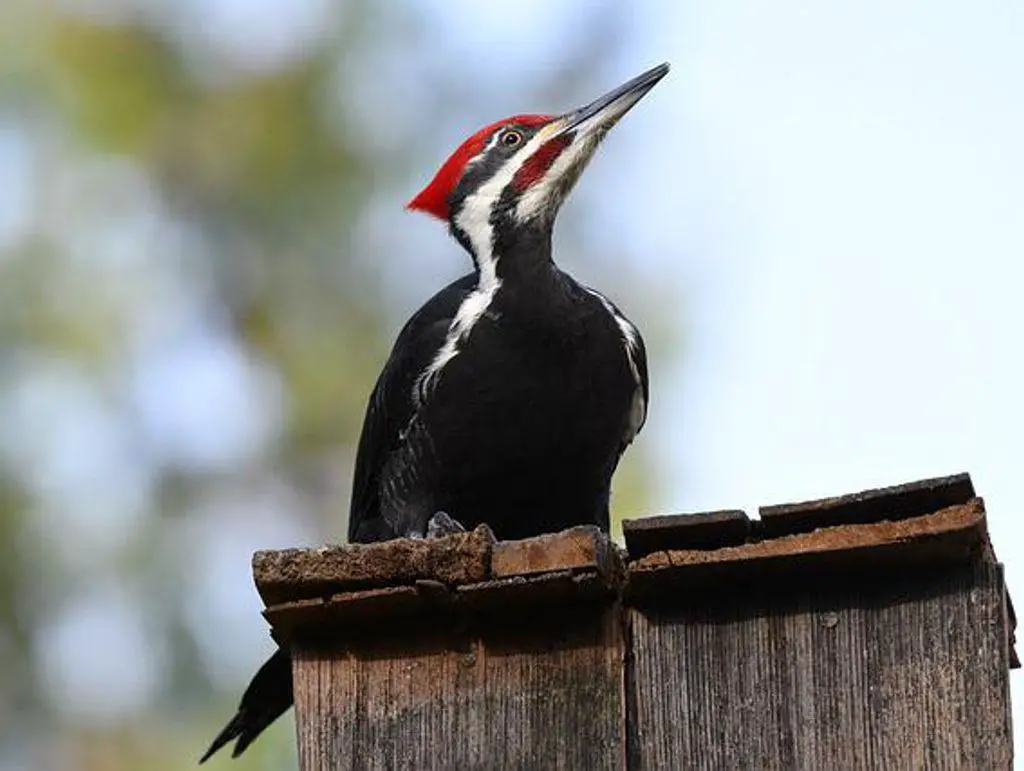Welcome to our ultimate guide on the 11 types of woodpeckers in New York! Woodpeckers are fascinating birds known for their distinctive drumming and pecking behaviors.
In this comprehensive guide, we’ll explore the diverse range of woodpecker species found in New York, from the majestic Pileated Woodpecker to the diminutive Downy Woodpecker.
Discover their unique characteristics, habitats, and behaviors, and learn how to identify them in the wild.
Whether you’re a seasoned birder or a curious nature enthusiast, this guide is your go-to resource for uncovering the wonders of New York’s woodpeckers.
Table of Contents
Types of Woodpeckers in New York
Downy Woodpecker
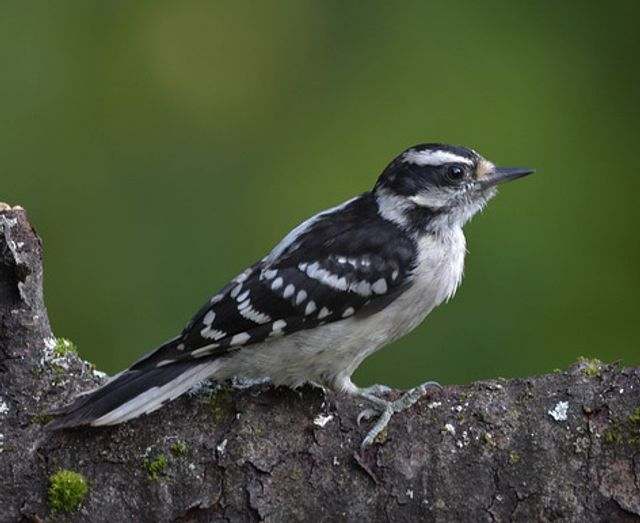
- Length: 5.5-6.7 in (14-17 cm)
- Weight: 0.7-1.0 oz. (21-28 g)
- Wingspan: 9.8-11.8 in (25-30 cm)
- Scientific Name: Picoides pubescens
- Frequency of Occurrence: 31.20% (Statistic by: eBird)
- Where To Find Them: Downy Woodpeckers are found in a number of locations in New York. These include both the north and south shores of Long Island, as well as parts of the Hudson Valley, including Albany and Schenectady. They are also found in Central New York, including Syracuse and Rochester.
- How to Attract: Plant an array of trees and shrubs that offer food and nesting sites for these birds. Downy Woodpeckers typically favor trees with spindly branches and dense foliage, so look for species like oak, maple, birch, hickory, or pine. Install suet feeders in strategic locations with peanut butter or insect suet near your home to provide them with nutritious fare.
Description: The Downy Woodpecker is a small woodpecker that can be found throughout much of North America. The distribution range of the Downy Woodpecker includes most of Canada and the United States.
The Downy Woodpecker prefers deciduous and mixed forests, but will also nest in urban areas. The Downy Woodpecker feeds on insects, especially ants and other invertebrates. It excavates a hole in a tree trunk or branch to make its home.
Handpicked Related Content: How to Attract Downy Woodpeckers to Your Yard? (Easy!)
Red-bellied Woodpecker
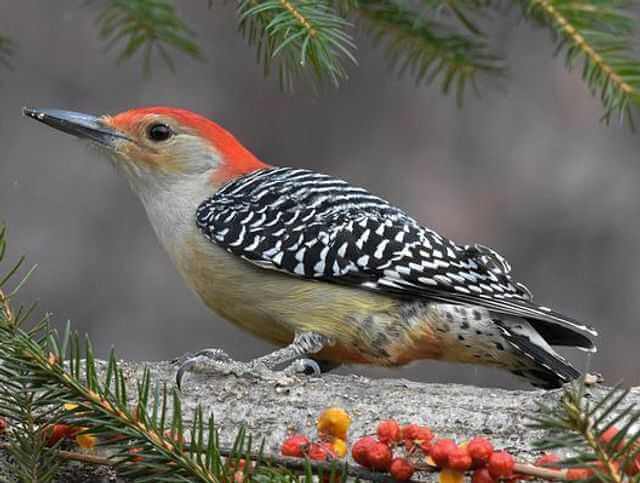
- Length: 9.5 in (24 cm)
- Weight: 2.0-3.2 oz. (56-90 g)
- Wingspan: 13.0-16.5 in (33-42 cm)
- Scientific Name: Melanerpes carolinus
- Frequency of Occurrence: 26.07%
- Where To Find Them: They can be found in many locations in New York, including but not limited to: Central Park, Prospect Park, Seneca Lake, and Oswego County.
- How to Attract: The Red-bellied Woodpecker can be attracted to your yard with suet blends, peanuts, mealworms, and sunflower seeds. Bark Butter is also a great food for them and can be found at most pet stores.
Description: The Red-bellied Woodpecker is found in much of the eastern United States, but is most common in the south. It prefers wooded areas with plenty of tree cavities, including oak, hickory, and maple trees.
The bird primarily eats insects and nuts, but they have been also known to feed on seeds, fruit, birds eggs, tree sap, minnows, tadpoles, and frogs. It makes a “tic” noise while feeding, which has been known to startle or alarm its prey. . It typically excavates a nest in a tree cavity. Both male and female red-bellied woodpeckers are responsible for building the nest, and share incubation duties.
Handpicked Related Content: How to Attract Red-bellied Woodpeckers to your Yard?
Northern Flicker
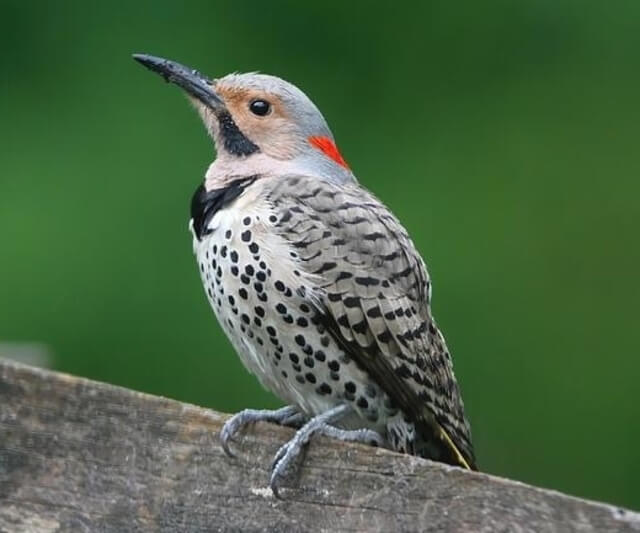
- Length: 11.0-12.0 in (28-31 cm)
- Weight: 3.9-5.6 oz. (110-160 g)
- Wingspan: 16.5-20.0 in (42-51 cm)
- Scientific Name: Colaptes auratus
- Frequency of Occurrence: 17.72%
- Where To Find Them: These birds prefer wide open spaces with plenty of trees for nesting, so areas like the Adirondacks and Catskills are good spots to look for them.
- How To Attract: To attract this bird to your yard, try providing a suet feeder filled with peanut butter and peanuts. Safflower seeds can also be added to the feeder as a complementary food source.
Description: The Northern Flicker is a medium-sized bird that resides in the boreal and temperate zones of North America. This species breeds in the eastern United States, from New England to the Gulf Coast, and winters in Central America and South America.The Northern Flicker feeds primarily on insects, but also consumes seeds and fruit.
It typically builds a stick nest in a tree cavity, but will also use abandoned birds nests or crows’ nests. This species has one of the widest distributions of any bird in North America. Breeding season commences in between March to June, with the female laying about 3-8 eggs and both parents sharing incubating duties. Incubation period is approximately 11-12 days.
Handpicked Related Content: How to Attract Northern Flickers to your Backyard (Easy)
Hairy Woodpecker

- Length: 7.1-10.2 in (18-26 cm)
- Weight: 1.4-3.4 oz. (40-95 g)
- Wingspan: 13.0-16.1 in (33-41 cm)
- Scientific Name: Picoides villosus
- Frequency of Occurrence: 12.58%
- Where To Find Them: The Hairy Woodpecker is a common sight in the forests of New York. They are most commonly found in the Adirondacks and Catskills, but have been seen as far south as the Bronx.
- How To Attract: First and foremost, make sure that your bird feeder is well-stocked with a variety of food sources. This includes a suet feeder with peanut butter suet and a platform feeder with black-oil sunflower seeds. You can also place a platform feeder near trees or other high points in your yard so that the woodpeckers have more places to perch. Finally, make sure to keep an eye on your feeders and give them regular cleanings.
Description: The Hairy Woodpecker is a medium-sized woodpecker that can be found in parts of North America. The distribution range of the Hairy Woodpecker includes parts of Canada, the United States, and Mexico. The bird prefers moist woods and can usually be found in areas with lots of trees.
The Hairy Woodpecker mainly feeds on insects, but will also consume small vertebrates including spiders and worms. It typically constructs its own stick nest in a tree hole or other sheltered location.
Pileated Woodpecker
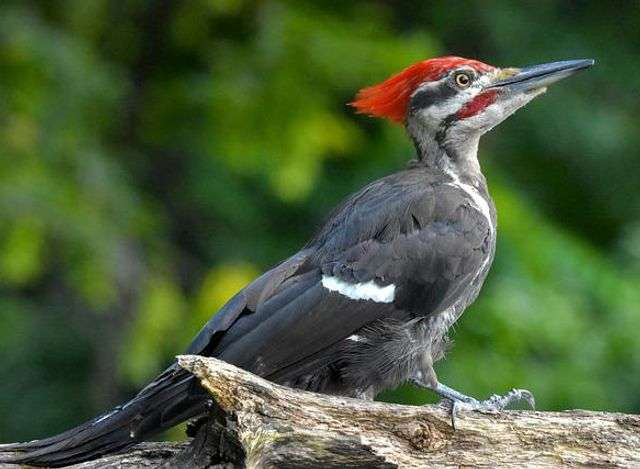
- Length: 15.8-19.3 in (40-49 cm)
- Weight: 8.8-12.3 oz. (250-350 g)
- Wingspan: 26.0-29.5 in (66-75 cm)
- Scientific Name: Dryocopus pileatus
- Frequency of Occurrence: 6.24%
- Where To Find Them: Pileated Woodpecker are only found in a small area of the Appalachian Mountains in New York. They like to live near large bodies of water such as lakes and rivers. There have been reports of them living in the suburbs of Buffalo, Rochester and Syracuse.
- How To Attract: One way to attract them is to feed them suet or bark butter smeared on a tree. Black-oil sunflower seeds can also be placed on a platform feeder. Nuts can also be an effective food source for these birds.
Description: Pileated Woodpecker is a medium-sized woodpecker found throughout the eastern and central United States. Their distribution range includes most of the eastern half of North America, including most of Canada. They inhabit mixed deciduous, coniferous and evergreen forests, but can also be found in urban areas.
Pileated Woodpeckers feed primarily on insects, which they catch by tapping on tree trunks with their bill, but will occasionally feed on fruits, berries and nuts. They typically excavate cavities in trees to build their nests, but will also use artificial structures such as abandoned rodent nests or birdhouses. Pileated Woodpeckers usually lay 2-5 eggs, which are incubated for about 17 days.
Handpicked Related Content: How to Attract Pileated Woodpeckers to your Yard (Fast)
Yellow-bellied Sapsucker

- Length: 7.1-8.7 in (18-22 cm)
- Weight: 1.5-1.9 oz. (43-55 g)
- Wingspan: 13.4-15.8 in (34-40 cm)
- Scientific Name: Sphyrapicus varius
- Frequency of Occurrence: 5.40%
- Where To Find Them: The Yellow-bellied Sapsucker is a small woodpecker that is found in locations in New York. They are most commonly found in the Adirondacks, but they have been seen as far south as Westchester County.
- How to Attract: They are attracted to trees with tree sap, which can be found on birch, maple, and oak trees. The birds like to eat insects that live on the tree sap, such as mosquitoes and beetles. They also enjoy eating berries such as raspberries and blueberries.
Description: The distribution range of the Yellow-bellied Sapsucker extends from southeastern Canada, through the eastern United States, and into central Mexico. They are typically found in deciduous and mixed hardwood forests, but they will also occupy pine plantations and other wooded habitats.
The Yellow-bellied Sapsucker is a migratory bird, traveling long distances in search of food and shelter. They feed primarily on tree sap and sapwood, but will occasionally eat small fruits and berries.. The nests of the Yellow-bellied Sapsucker are typically located in cavities in trees.
Handpicked Related Content: 16 Interesting Sapsucker Facts Revealed!
Red-headed Woodpecker
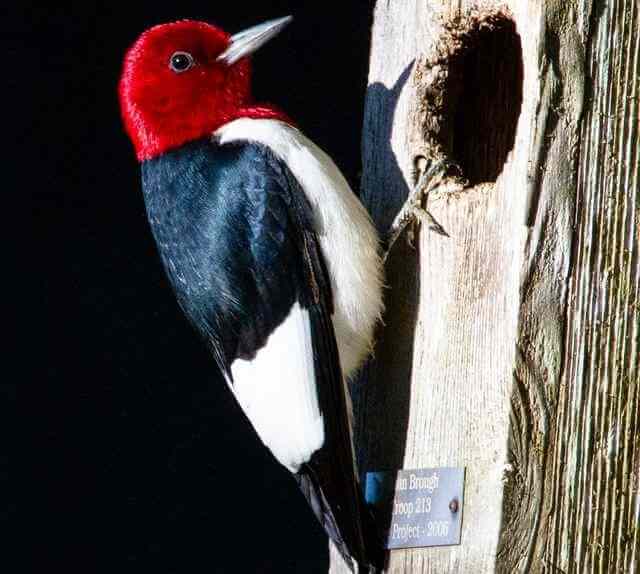
- Length: 7.5-9.1 in (19-23 cm)
- Weight: 2.0-3.2 oz. (56-91 g)
- Wingspan: 16.5 in (42 cm)
- Scientific Name: Melanerpes erythrocephalus
- Frequency of Occurrence: 0.4135%
- Where To Find Them: They can be found in many locations throughout New York, including upstate areas like Westchester County and Long Island, as well as cities like New York City and Buffalo.
- How to Attract: If you want to attract the red-headed woodpecker to your yard, one easy way is to make sure there are suet cubes available for them to eat. You can also smear bark butter on a tree or feeder and scatter black-oil sunflower seeds around. Finally, put out some nuts and fruit for them to enjoy.
Description:The red-headed woodpecker is a common bird in North America. It ranges from the southern parts of Canada down to Central America and across most of the United States. The red-headed woodpecker is also found in parts of South America and Europe.
The red-headed woodpecker is found in a variety of habitats, including deciduous and coniferous forests, but prefers areas with lots of trees and some open space. The red-headed woodpecker feeds on insects, especially beetles, spiders, and caterpillars. The red-headed woodpecker constructs its own cavities in trees for nesting purposes.
Handpicked Related Content: Interesting Red-Headed Woodpecker Facts (Explained)
Black-backed Woodpecker
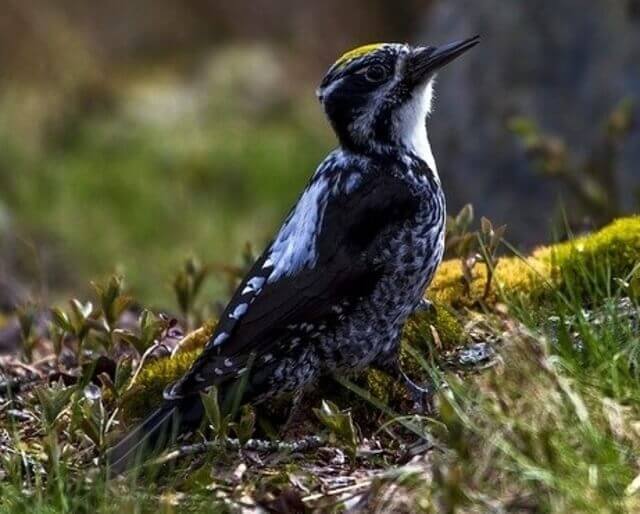
- Length: 9.1 in (23 cm)
- Weight: 2.1-3.1 oz. (61-88 g)
- Wingspan: 15.8-16.5 in (40-42 cm)
- Scientific Name: Picoides arcticus
- Frequency of Occurrence: 0.0724%
- Where To Find Them: They can be found in many different locations, but some of the more popular ones include Central Park and Prospect Park.
- How to Attract: This bird is attracted to suet, bark butter smeared on a tree, black-oil sunflower seeds on a platform feeder, acorns, and fruit. A feeder filled with these types of items will help attract this bird to your yard.
Description: The Black-backed Woodpecker is a common bird in North America. It ranges from the eastern seaboard of the United States, through most of Canada, to central Mexico. The Woodpecker is typically found in areas with large trees and plenty of dead wood. It prefers to build its nest in a cavity, but will use other cavities such as holes in vertical cliffs or even on the ground.
The Woodpecker feeds mainly on insects, such as the larvae of wood-boring beetles, ants termites, spiders, sand occasionally seeds, nuts and fruit, if they are available.
American Three-toed Woodpecker

- Length: 8.3-9.1 in (21-23 cm)
- Weight: 1.6-2.4 oz. (44.8-67.9 g)
- Wingspan: 14.6-15.3 in (37-39 cm)
- Scientific Name: Picoides dorsalis
- Frequency of Occurrence: 0.0013%
- Where To Find Them: They are typically found in areas with lots of tree coverage, such as the forests around Rochester and Syracuse.
- How to Attract: Set up a platform feeder filled with mealworms. Black-oil sunflower seeds are also a great option for attracting these birds, as they love to eat them. You can also try providing fruit trees and other food sources in your yard, as black-backed woodpeckers are cavity nesters.
Description: The American Three-toed Woodpecker is a medium-sized bird that can be found in most of the United States. It is the only woodpecker in North America with three toes on its feet. Its distribution range includes most of the eastern half of the continent, from southern Canada to South Carolina.
The woodpecker’s habitat includes hardwood and conifer forests, as well as suburban areas. It feeds on insects, especially ants and termites, which it finds in cavities in trees. American Three-toed Woodpeckers usually lay three to seven eggs per year.
Lewis’s Woodpecker

- Length: 10.2-11.0 in (26-28 cm)
- Weight: 3.1-4.9 oz. (88-138 g)
- Wingspan: 19.3-20.5 in (49-52 cm)
- Scientific Name: Melanerpes lewis
- Frequency of Occurrence: 0.0011%
- Where To Find Them: Lewis’s Woodpecker can be found throughout much of New York state. They are most commonly seen in the Adirondacks and in the Catskills, but they have also been spotted in western New York and Central New York.
- How to Attract: Suet is a key ingredient for attracting these birds. Make sure to include plenty of suet in your suet feeder, either as balls or cubes. Black-oil sunflower seeds on a platform feeder, also work well as a food source for Lewis’s Woodpeckers. Mealworms are another favorite food of these birds, so make sure to include them in your feeder mix as well. Try feeding them on a platform feeder located near a tree trunk or fence post where they can easily access the worms.
Description: Lewis’s Woodpecker is a species of woodpecker found in the eastern and central United States. The distribution range includes parts of Missouri, Arkansas, Tennessee, Kentucky, Ohio, Indiana, Illinois and Michigan. The woodpecker prefers deciduous and mixed forests with some areas of open woodland.
The diet consists mainly of insects but can also consume small nuts such as acorns and more, as well as fruit. Lewis’s Woodpecker nests in existing nest holes or excavates its own cavities into dead wood, usually selecting those that are close to the ground or have several holes already drilled into them.
Williamson Sapsucker

- Length: 7.9-9.8″ in. (20-25 cm)
- Weight: 1.6-1.9 oz (44-55 g)
- Wingspan: 16.5-17 in (42-43 cm)
- Scientific Name: Sphyrapicus thyroideus
- Frequency of Occurrence: 0.0000%
- Where To Find Them: The Williamson Sapsucker is a medium-sized woodpecker that can be found in various locations in New York City. These birds can often be found in heavily wooded areas, in the Bronx and Manhattan, where they forage for insects and other small creatures.
- How to Attract: You can create food sources by planting berries or other insect-rich plants. You can also add artificial nests to trees or shrubs in your yard; these will help the Williamson Sapsucker raise their young.
Description: The Williamson Sapsucker is a small, cavity nester that inhabits areas of eastern North America. The distribution range of this bird ranges from Nova Scotia and Prince Edward Island in the north to central Florida and west to Arkansas. This species prefers deciduous and mixed forests but can also be found in coniferous forests.
The diet of the Williamson Sapsucker consists mainly of insects, but they will also eat tree sap. They are cavity nesters, typically nesting in trees but sometimes use other cavities such as abandoned woodpeckers’ nests.
Related Post: Most Common Backyard Birds in New York (Explained)

